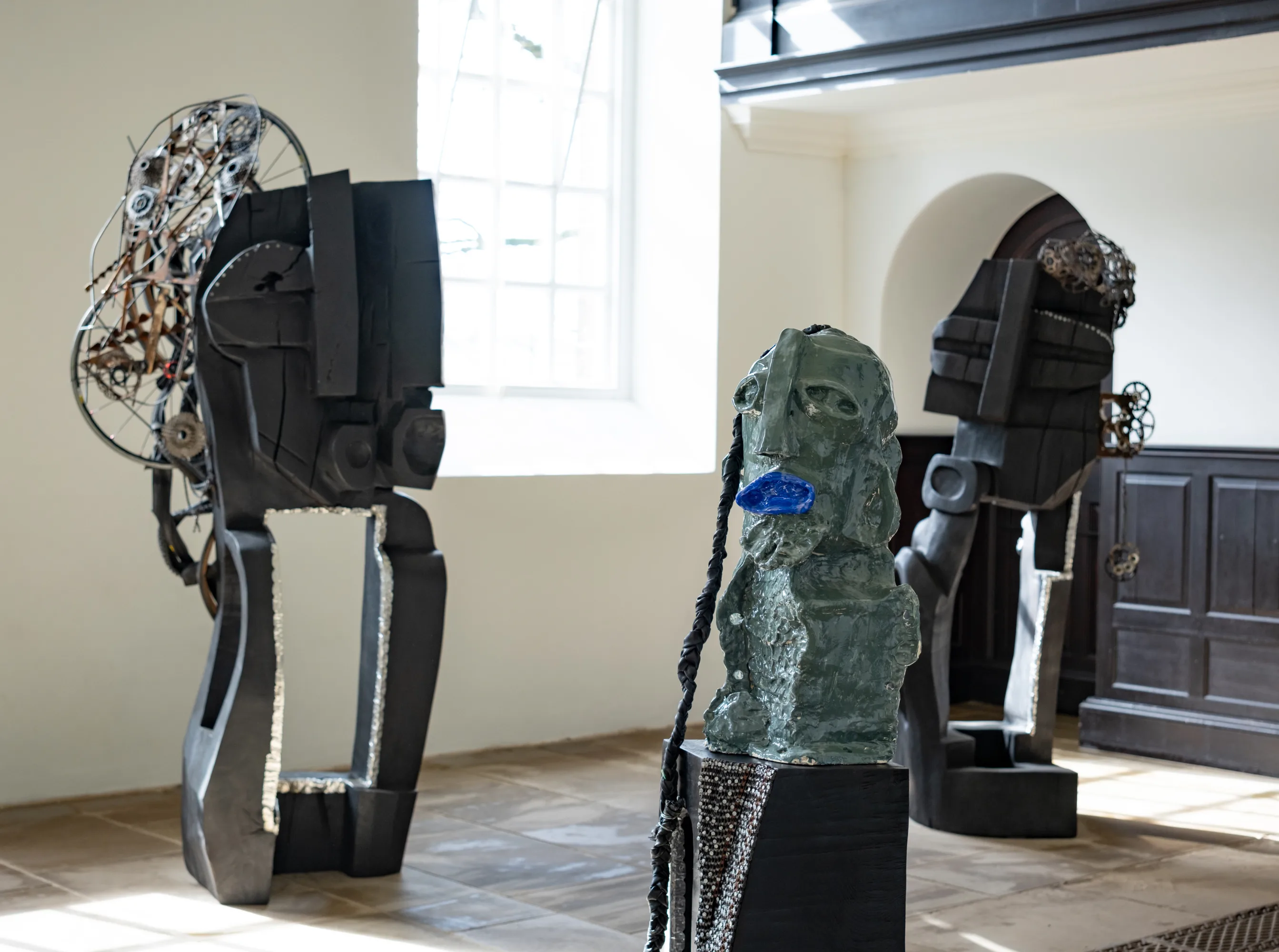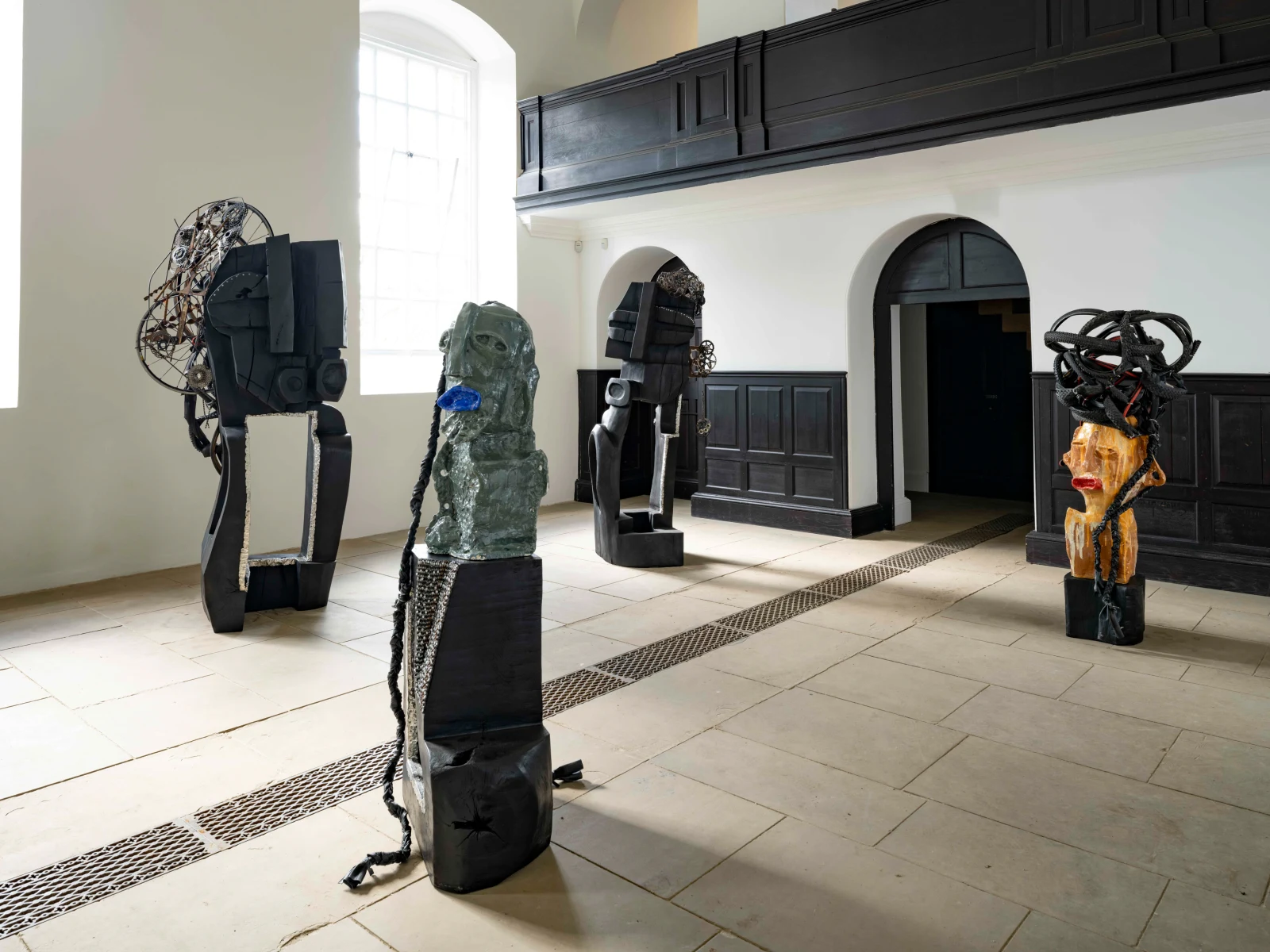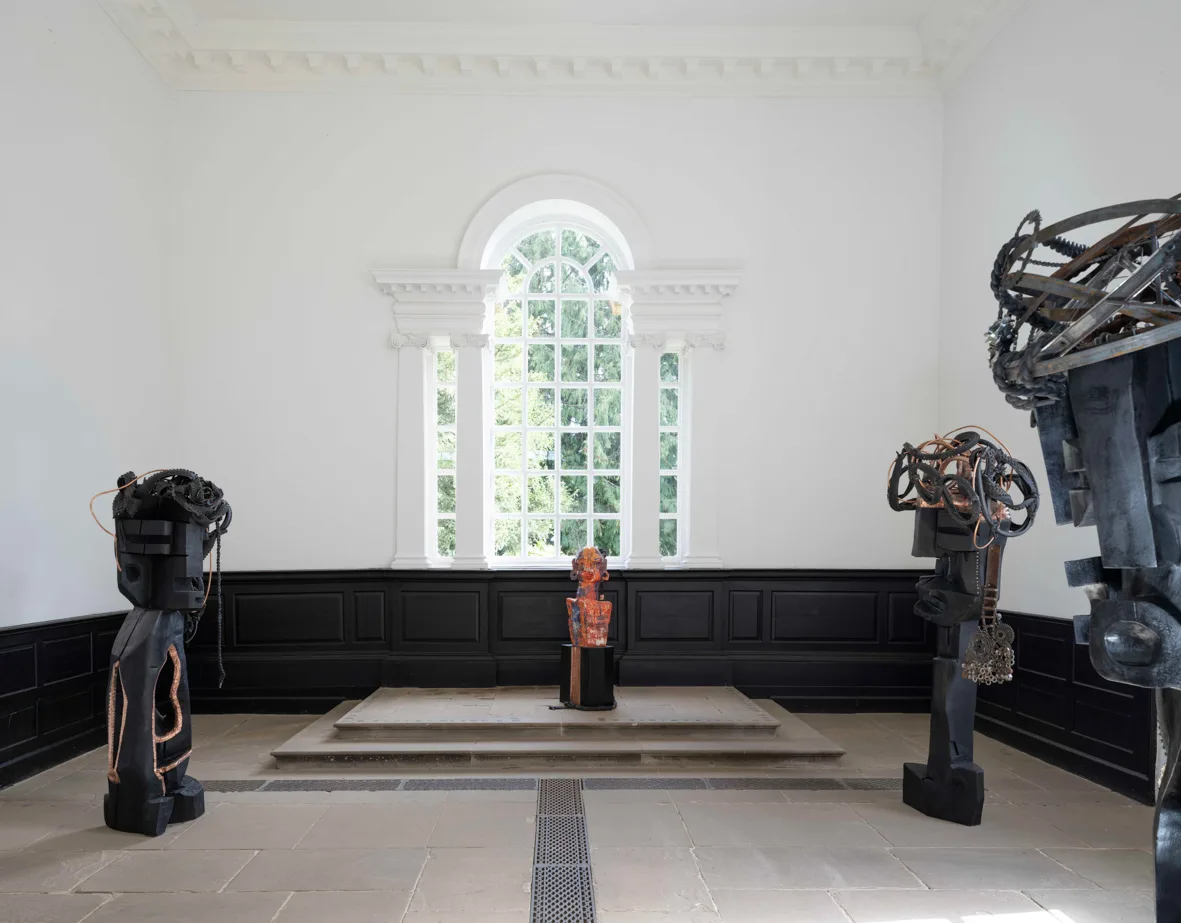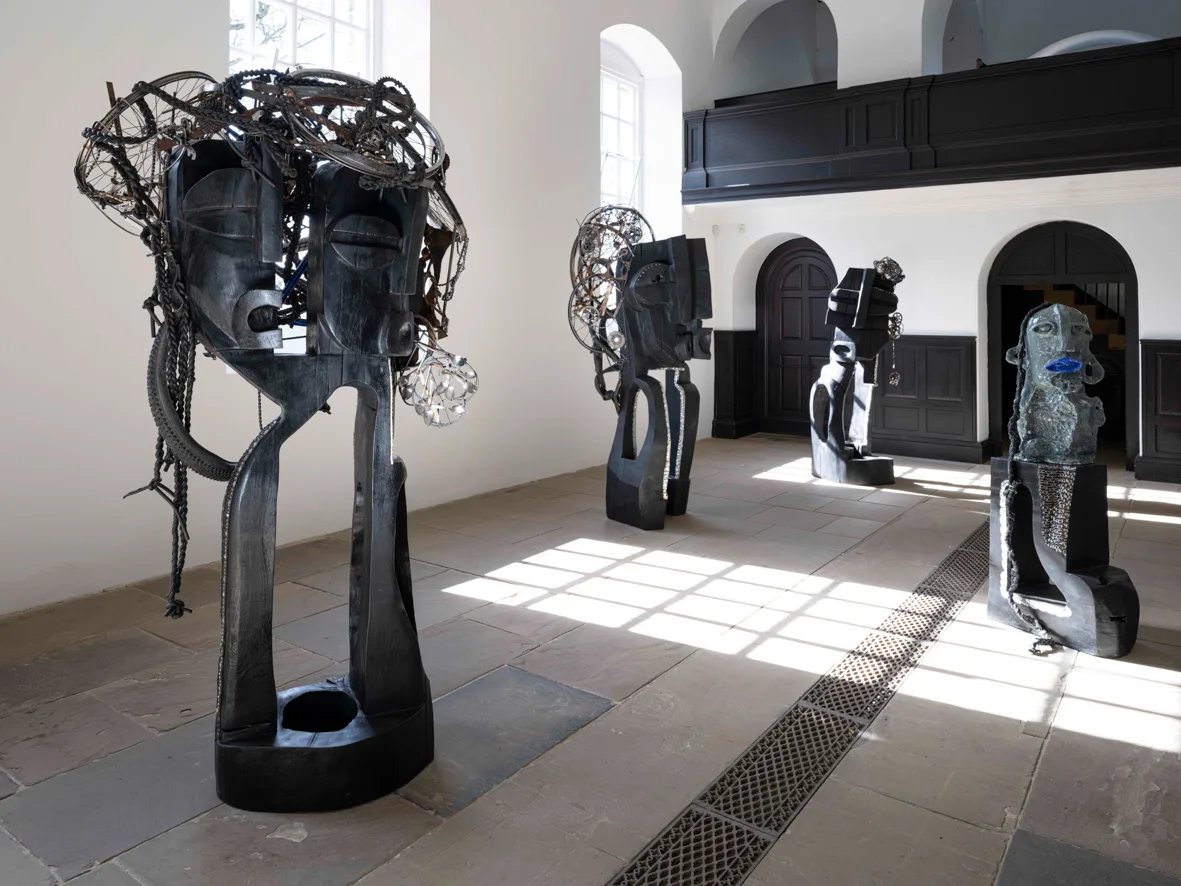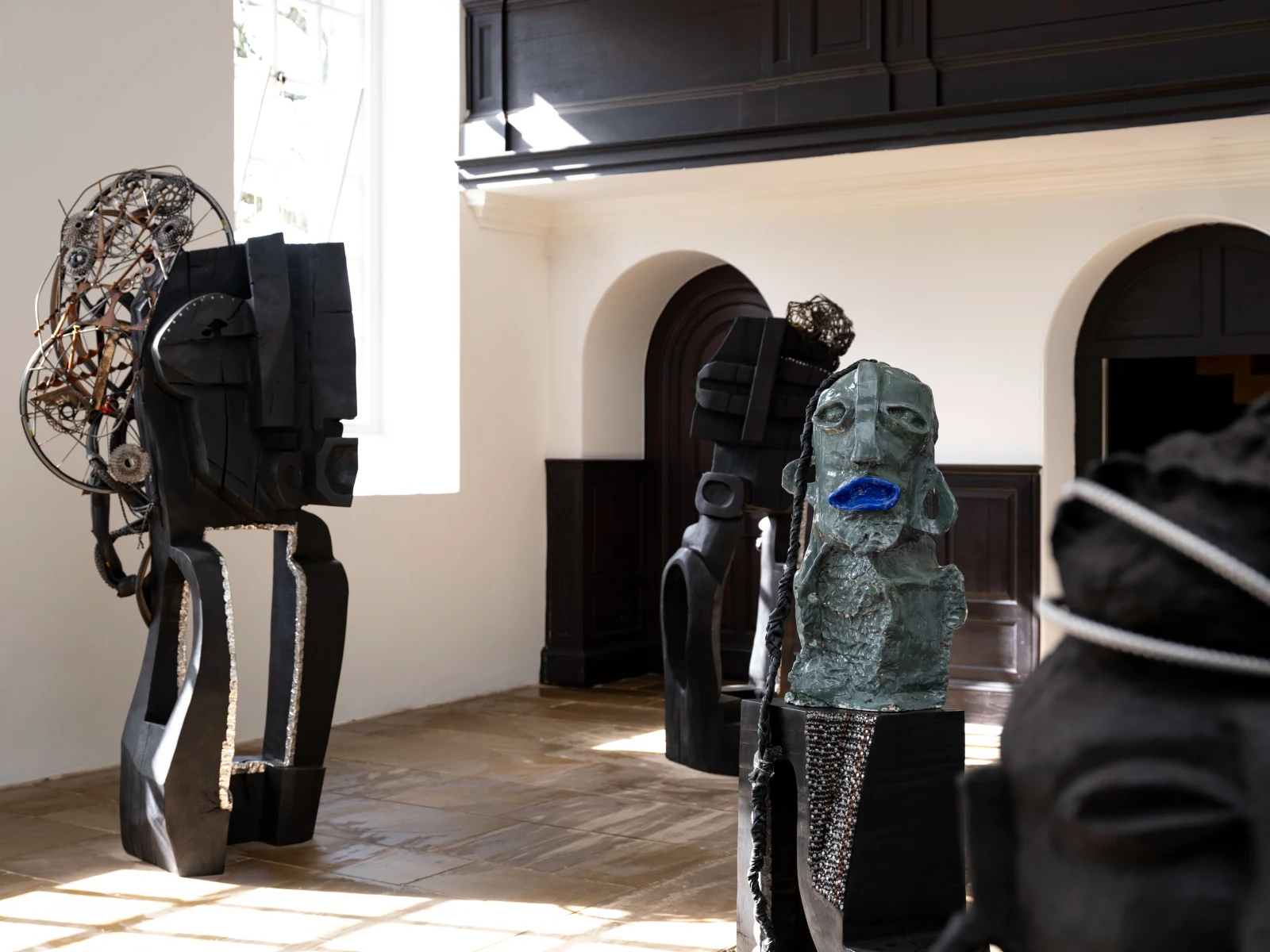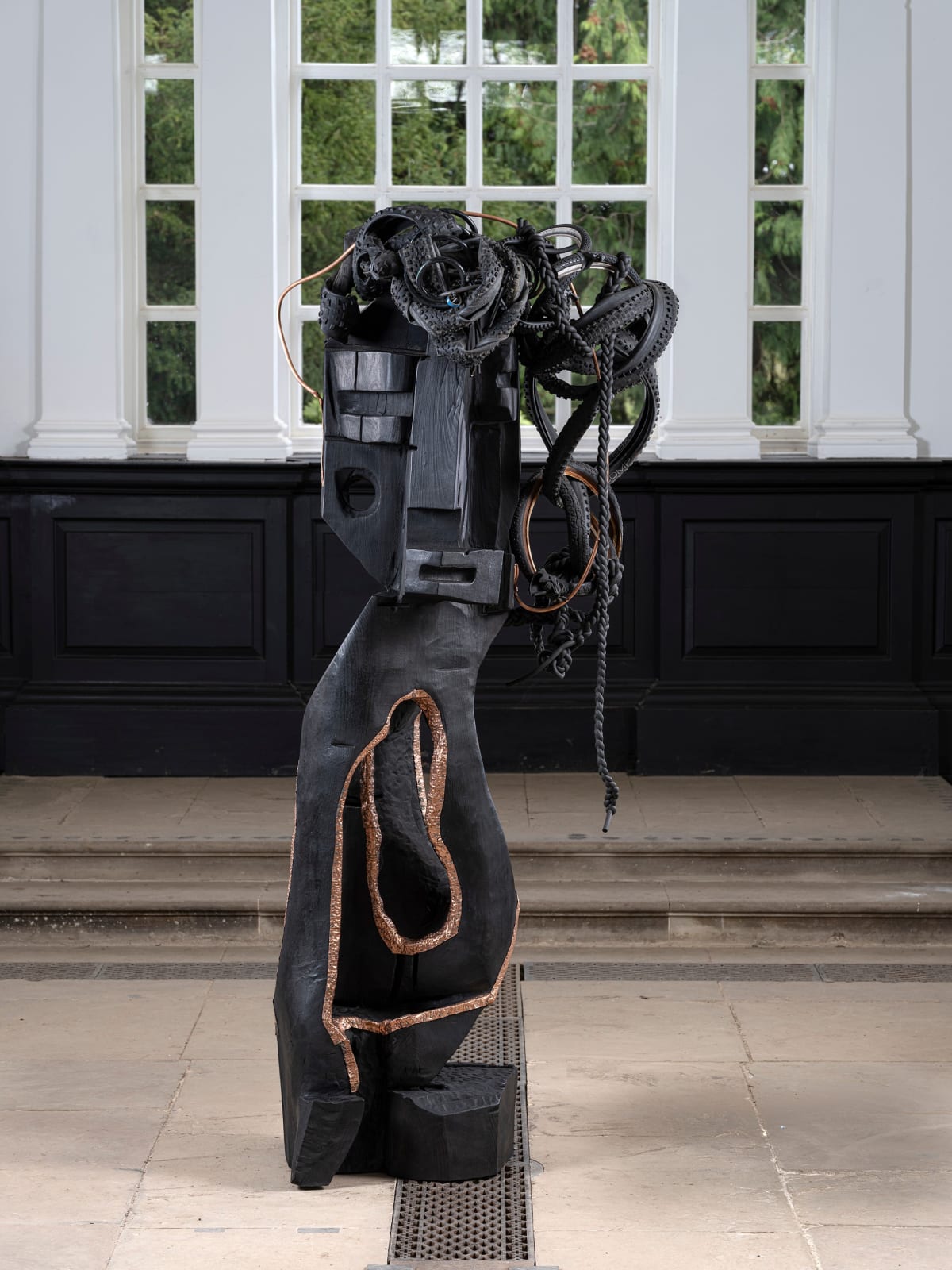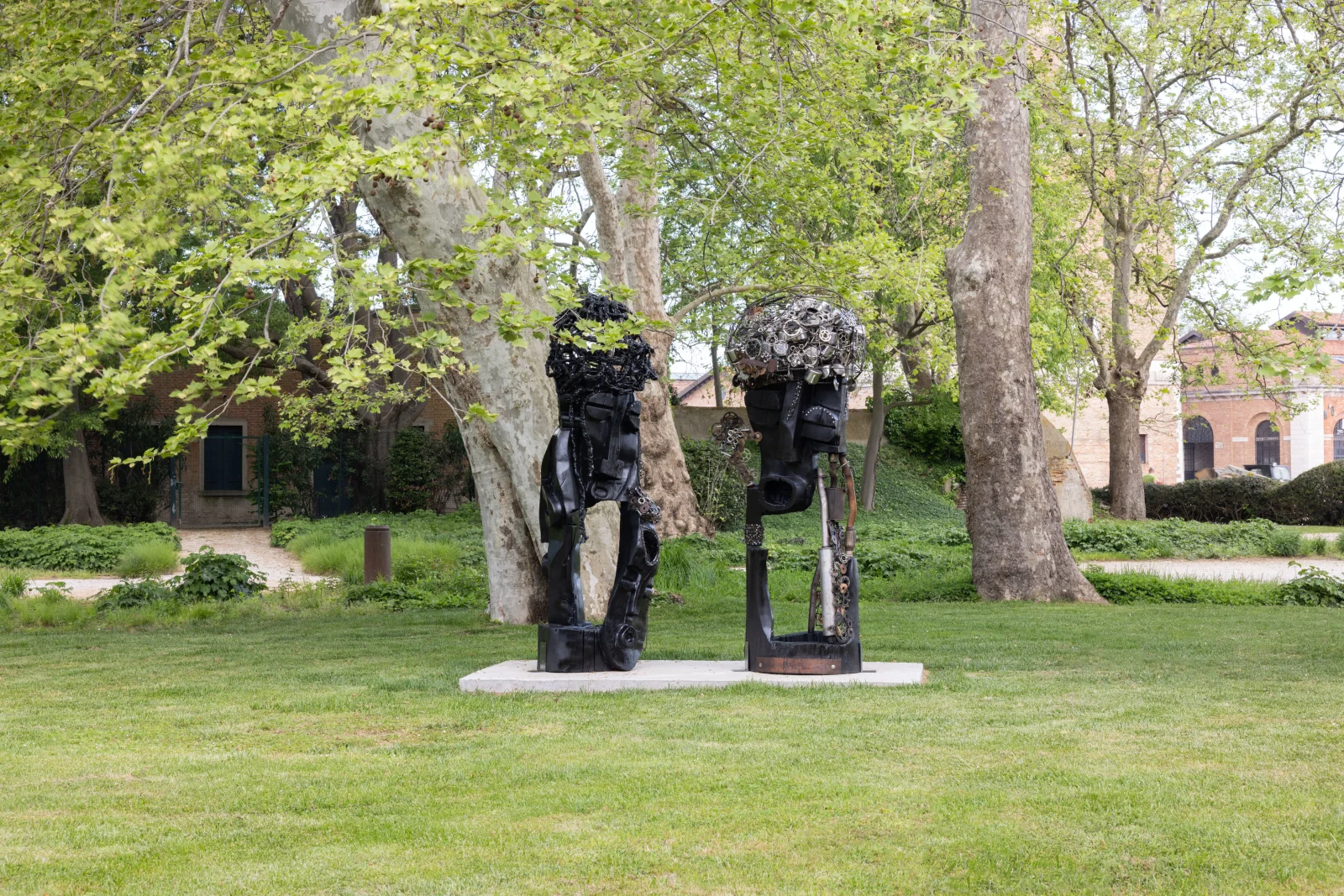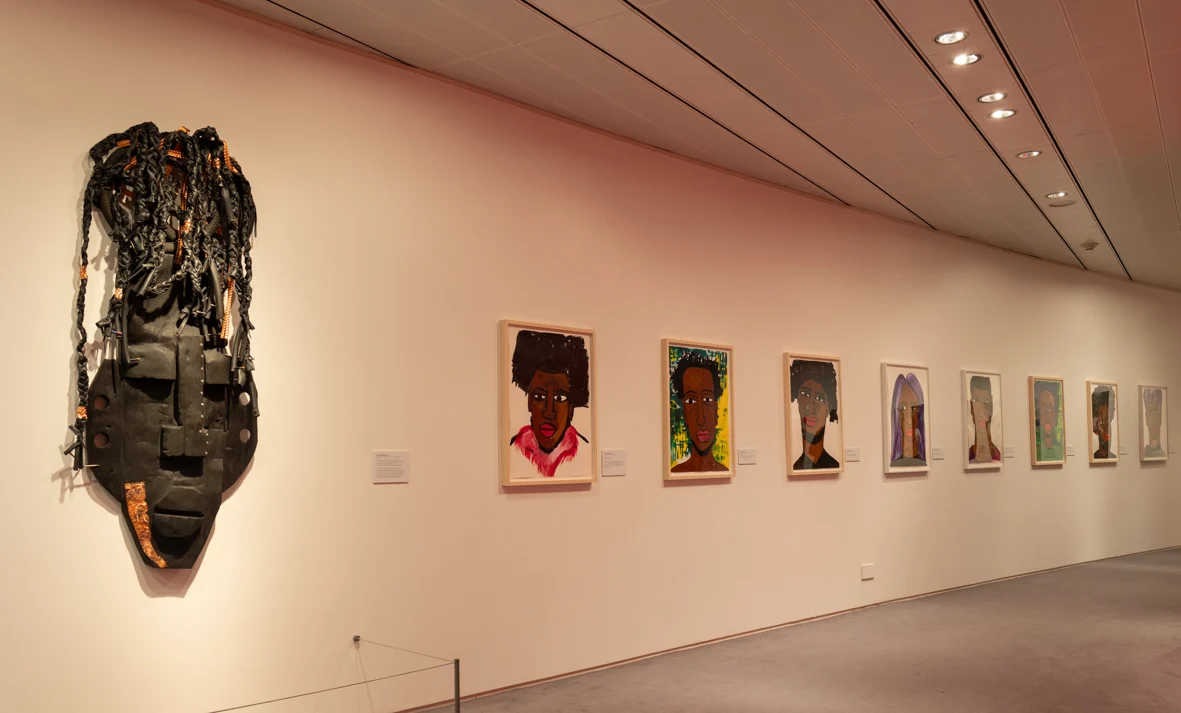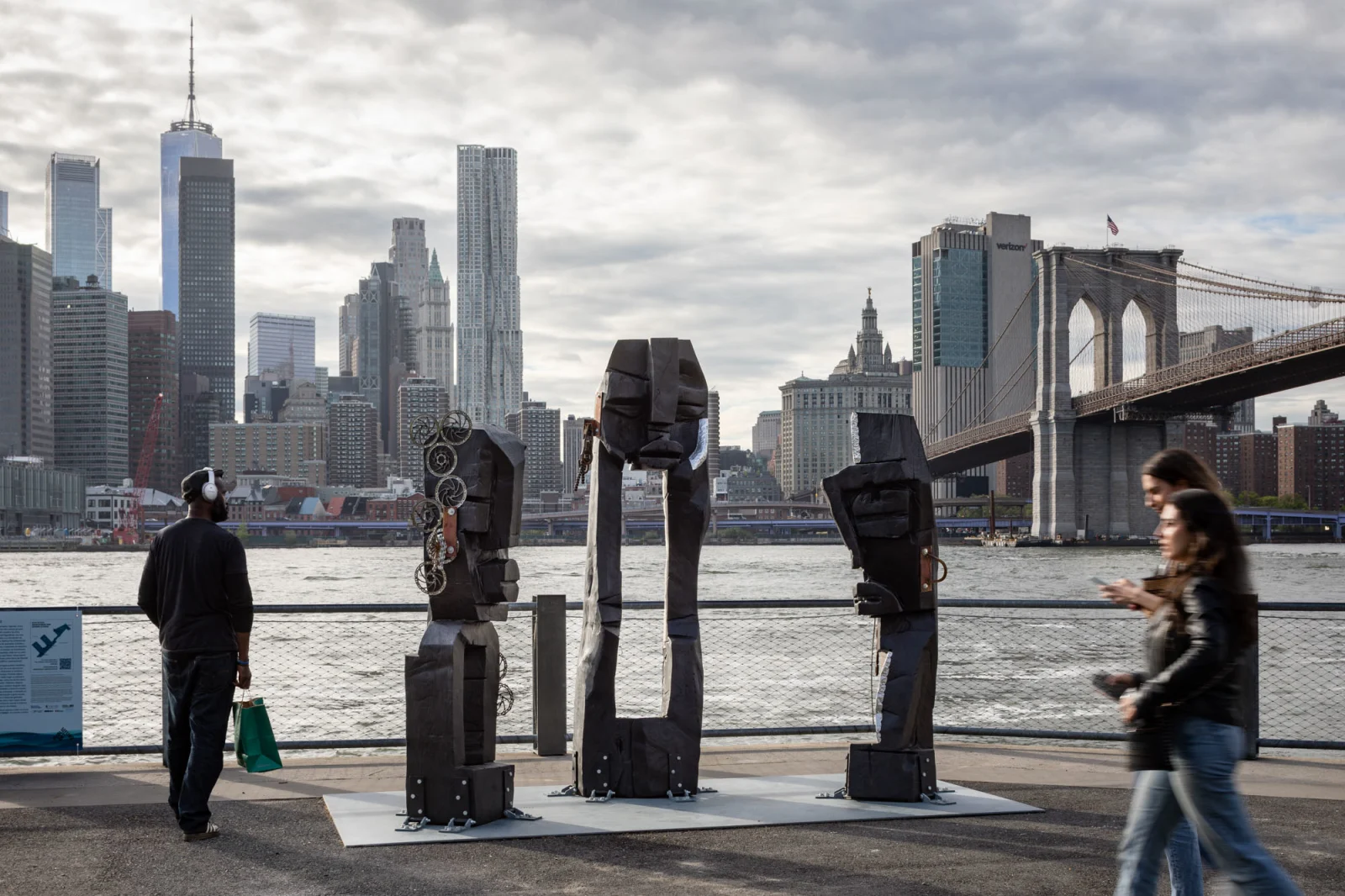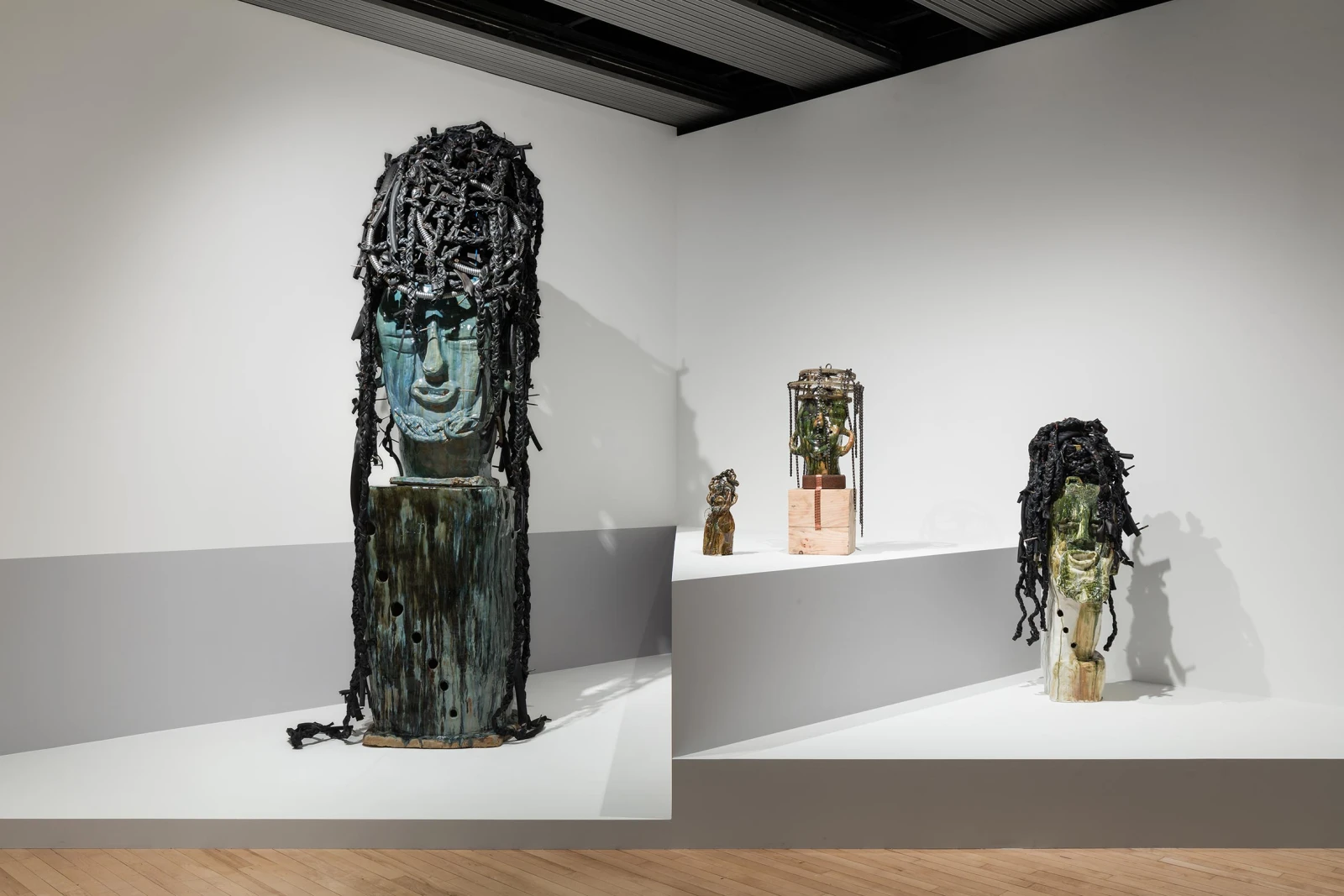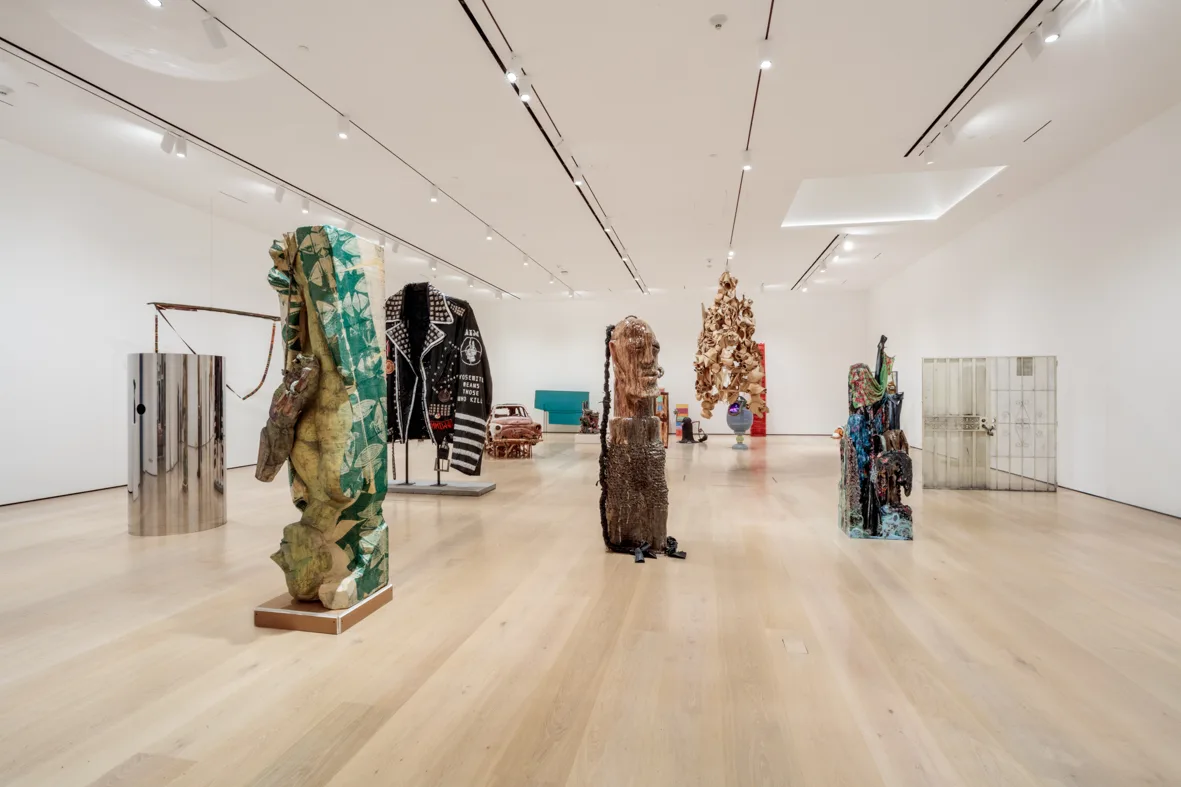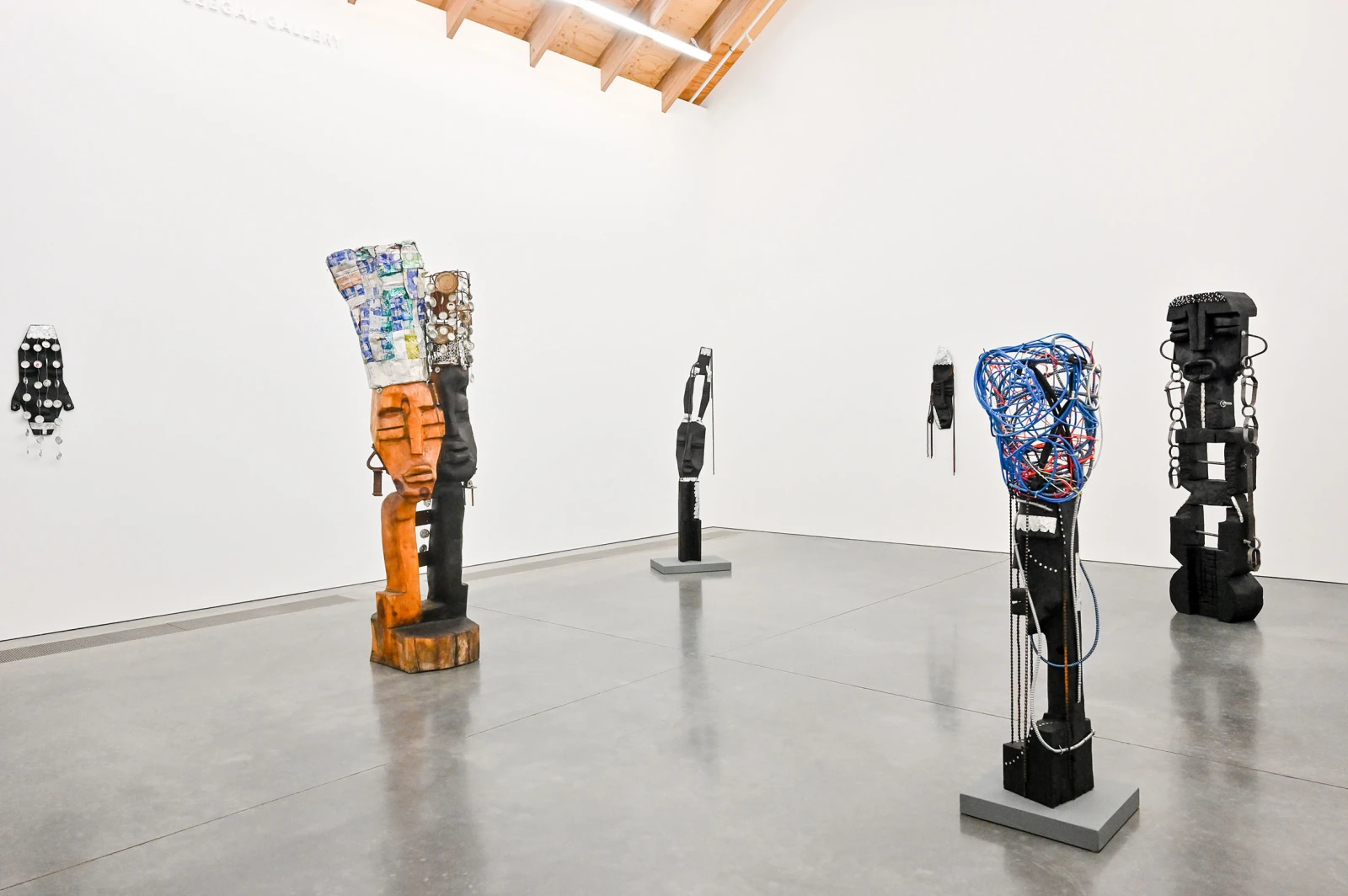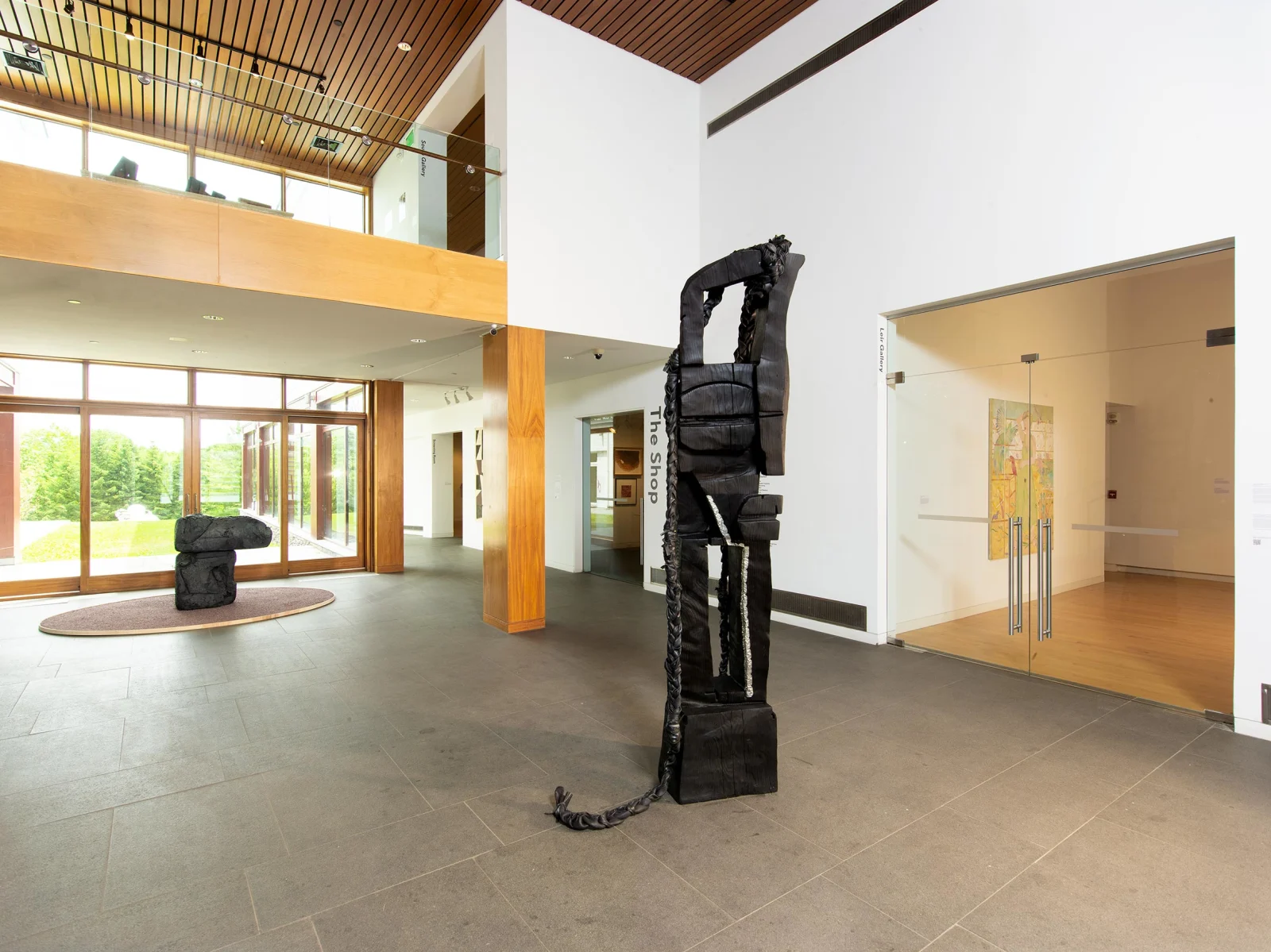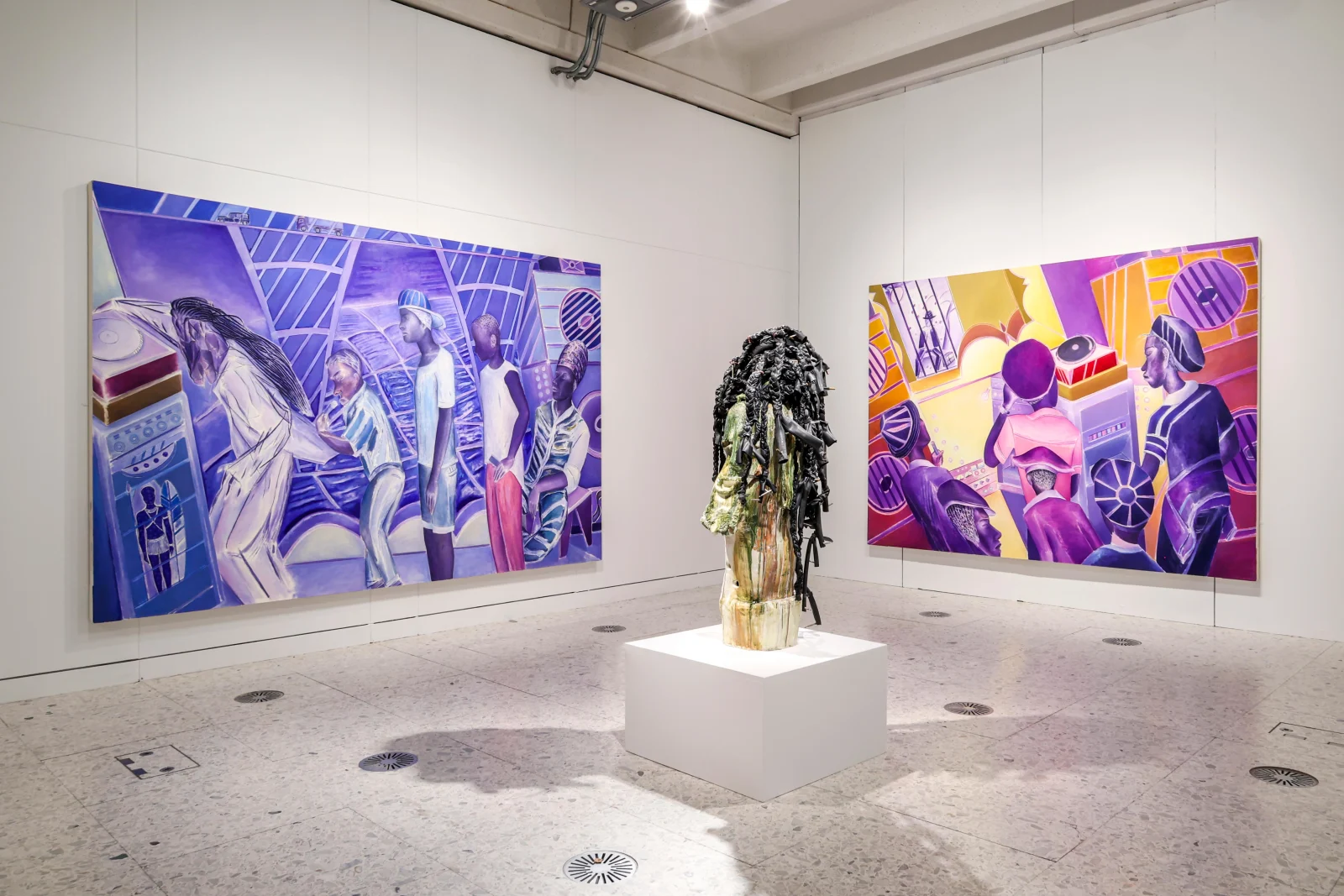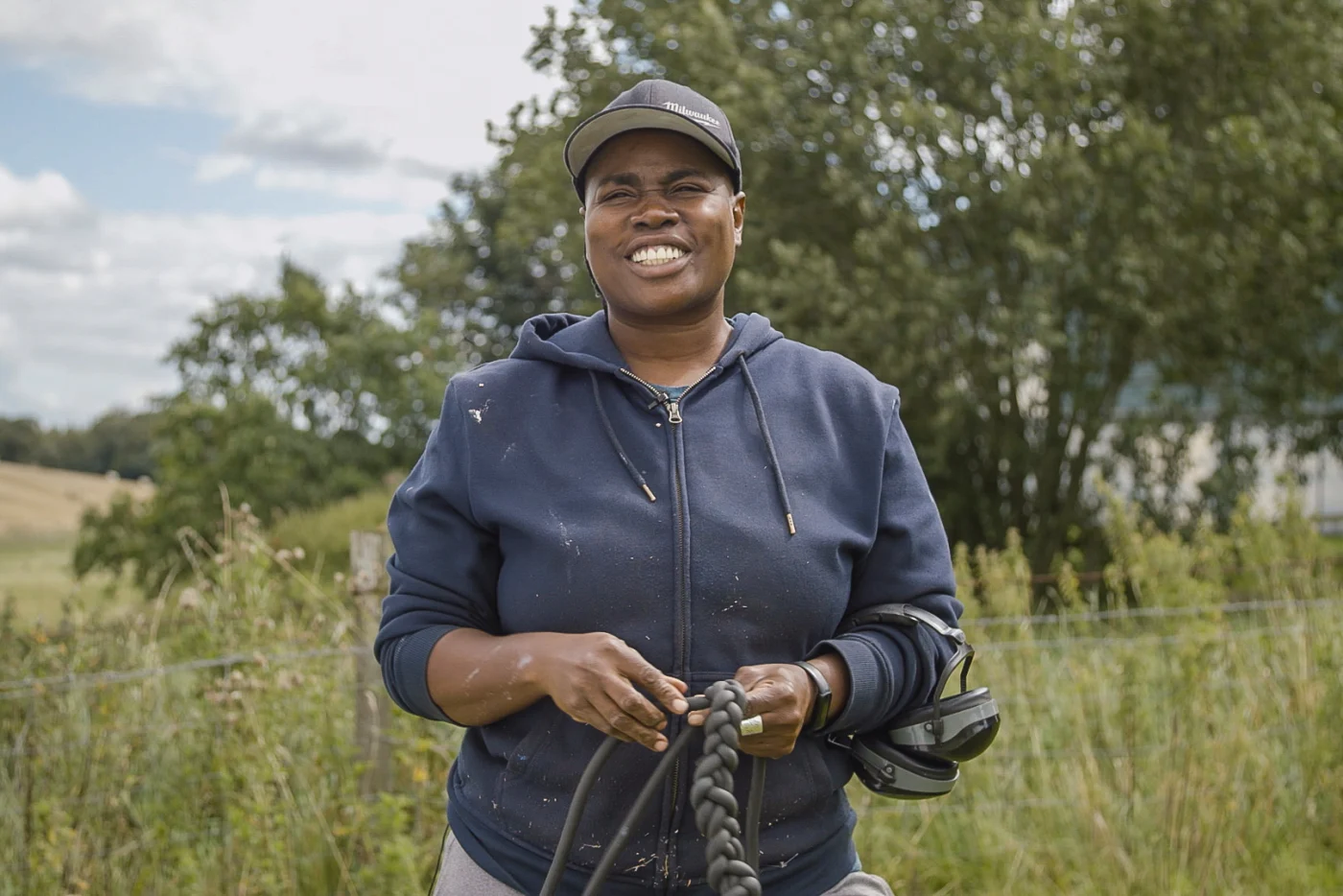Overview
Leilah Babirye’s exhibition 'Obumu (Unity)' features new sculptures made at Yorkshire Sculpture Park specifically for this exhibition, largely from materials found onsite.
Babirye spent the summer of 2023 at YSP making a clan of seven larger-than-life-size figures in wood and five coloured ceramics. Supported by YSP’s onsite technical team and artists, seven sculptures were carved using a chainsaw and chisels from a 200-year-old fallen beech tree at the Park. Babirye describes being guided by the wood itself, sketching the initial forms directly onto the sectioned tree for carving. Once carved, the figures are refined and their surfaces sanded back to highlight the grains of the tree. The sculptures are then burned a deep black, which the artist used to do to make the works ‘disappear’, but is now a gesture of celebrating their beauty. Details of the sculptures are treated with a blowtorch and then all the surfaces carefully waxed to acknowledge the skin of the piece and the tree from which it came. The final stage is one Babirye has called ‘taking the girls to the salon’, in which found elements complete the sculptures, including bicycle chains, nails and copper from a dismantled boiler, as well as redundant silver tea pots.
Babirye spent the summer of 2023 at YSP making a clan of seven larger-than-life-size figures in wood and five coloured ceramics. Supported by YSP’s onsite technical team and artists, seven sculptures were carved using a chainsaw and chisels from a 200-year-old fallen beech tree at the Park. Babirye describes being guided by the wood itself, sketching the initial forms directly onto the sectioned tree for carving. Once carved, the figures are refined and their surfaces sanded back to highlight the grains of the tree. The sculptures are then burned a deep black, which the artist used to do to make the works ‘disappear’, but is now a gesture of celebrating their beauty. Details of the sculptures are treated with a blowtorch and then all the surfaces carefully waxed to acknowledge the skin of the piece and the tree from which it came. The final stage is one Babirye has called ‘taking the girls to the salon’, in which found elements complete the sculptures, including bicycle chains, nails and copper from a dismantled boiler, as well as redundant silver tea pots.
During her time at YSP, Babirye also sculpted five large ceramic portrait-sculptures, each its own personality. They are created from coiled clay and boldly shaped into fundamental forms in which traces of the artist’s strong hands and fingers can be seen, before being fired and heavily coated with dense glazes that on firing contribute to the sculptures’ earthy, elemental power. Together the works will make a robust, rich statement in YSP’s Chapel, built in 1744, around the same time that the beech tree began to grow. Painterly glazes contrast with chiselled, roughly-textured woodwork and metal objects associated with the art of blacksmithing. The artworks become a congregation that celebrates community in all its forms in this beautiful and contemplative space, which has witnessed key moments in now-forgotten lives for centuries.
Babirye’s practice originally began as activism, as a gay woman in her home country of Uganda, where being gay is illegal and risks the death penalty. Babirye’s use of discarded materials references the prejudiced slang for a gay person in the Luganda language – ‘abasiyazi’ – which is the part of the sugarcane husk that is rubbish, thrown out. Her practice integrates her own unique approach to making art with her culture and heritage and long-standing sculpture traditions such as mask making. She was partly inspired by the work of Henry Moore as a student, who himself drew from artefacts from the African continent, and whose sculptures are on permanent display at YSP in his home county of West Yorkshire.
Babirye acknowledged at Yorkshire Sculpture Park that she began to make art from real pain but now she feels blessed to be doing what she is doing, to create and adore who we all are.
Leilah Babirye’s exhibition 'Obumu (Unity)' features new sculptures made at Yorkshire Sculpture Park specifically for this exhibition, largely from materials found onsite.
© Jonny Walton, courtesy of Yorkshire Sculpture Park
“Leilah’s uncompromising sculpture always packs a punch. That these sculptures were created at YSP, with Leilah making the most of what this place has to offer, is very special. For almost 300 years, our Chapel has been a place for community and contemplation, and we’re privileged that Leilah has made it a home for her clan of compelling artworks.”
Claire Lilley, Director, Yorkshire Sculpture Park

Babirye’s sculptures take on oversized human forms. The artist manipulates construction grade lumber, scrap metal, clay, and found objects to devise sculptural communities of queer Ugandans with unique names and clan identities. In order to shape raw materials into refined, finished sculptures, Babirye must subject them to harsh processes. Surfaces are carved with a chainsaw, charred until black, and fastened to one another. “Through the act of burning, nailing, and assembling,” the artist explains, “I aim to address the realities of being gay in Uganda and Africa in general.”
Displayed within the meditative space of the Yorkshire Sculpture Park Chapel, Babirye’s oversized sculptures are softened by their surroundings. They find their place amongst a collection of clay busts and wooden statues, standing alongside members of the Lungfish, Egret, and Leopard clans. Babirye reveals, “I assign our family names to my sculptures so we can live forever.”

Leilah Babirye crafts her sculptures from large, roughly hewn pieces of wood. Her work is an interplay between hard and soft, rough and finished; she fearlessly combines angular forms with rounded edges. ‘Wamala from the Nngonge (Otter) Clan’ is a tall, narrow bust, with the head fixed on an elegant, giraffe-like neck. On the face, a straight nose establishes an axis of symmetry, while the figure’s parted lips make them appear to be mid-sentence, or mid-song.
‘Nakakeeto from Kuchu Mutima (Heart) Clan’ towers over the viewer, with Babirye’s favoured geometric features on full display; quadrilateral shapes are hewn from beech to form the sculpture’s eyes, nose, and mouth. “Wood feels like sketching on paper with a chainsaw, where no mistakes can be reversed,” Babirye says, “I always embrace them as they are meant to happen.” Nakakeeto is a cyborg, possessing a body that is a stark blend of wood and metal. Around the figure’s neck, a thick chain has been fashioned into a necklace. This sculpture captures the true interdisciplinary nature of Babirye’s practice, as the artist seamlessly melds elements of timber, metal, and ceramic in her body of work.

Leilah Babirye’s practice is characterised by a deep sense of reverence for her materials, her sculptural forms the result of meaningful exchange between medium and artist. When working with wood, Babirye is in utter control, but allows herself to be guided by the structure and grain of the wood itself. The materiality of clay, however, imposes its own restrictions upon the artist: “Ceramics is the only place where I feel like the medium tells you when to stop; clay tells you when to stop because you can’t exceed it…It’s the only material that controls you.” Whether sawing or sculpting, Babirye is in constant dialogue with her materials.

‘Kalibbala from the Kuchu Nsenene (Grasshopper) Clan’ is a ceramic bust with glaze that has been spattered and poured over the clay body. The result has all the spontaneity of an abstract expressionist painting, with textured regions of overlapping colours and drips of glaze that have hardened in the firing process. Kalibbala’s face draws inspiration from the stylistics of wooden African masks, with exaggerated and expressive features that imbue the form with personality and liveliness.
“Leilah Babirye’s sculptural figures and heads succeed where many fail: They build convincingly on universally revered traditions from the past — in this case the sculptural styles of West Africa.”
Roberta Smith, New York Times

For a processual artist like Babirye, the creation of a piece is just as important as the finished product. Kneading and shaping clay are therapeutic acts for the artist who explains, “Clay relaxes me, makes me compromise, urges me to say please sometimes.”
‘Nakyeyune from the Kuchu Nyonyi Nnyange (Egret) Clan’ is a mixed media sculpture, consisting of a rounded ceramic effigy placed on a charred beech pedestal adorned with a waterfall of silver metal. Nakyeyune’s features are expressive and open, resembling those of a wooden African mask. Through both bust and pedestal, Babirye shows off her mastery in crafting shapes, bestowing Nakyeyune with carefully arranged hair like a crown, and preserving the organic form of the beech.

Gyagenda is Leilah Babirye’s first bronze sculpture, continuing the multidisciplinary artist’s ongoing tradition of imagining and creating a community of queer Buganda clanspeople. Babirye transforms found materials into embellishments for her ceramic and wooden sculptures that consider themes of identity, sexuality, personal history and resilience; her practice also includes painting and drawing. The work’s title is a Luganda idiom, a moniker often given to young people going forth in the wider world to gather their chosen families.
Talk Art speak to artist Leilah Babirye to discuss her inspiring multidisciplinary practice, her major solo show at Yorkshire Sculpture Park and new sculptures in the Venice Biennale 2024.

Artist Biography
Babirye was born in 1985 in Kampala, Uganda. She lives and works in Brooklyn, New York. She studied art at Makerere University in Kampala (2007–2010) and participated in the Fire Island Artist Residency (2015). In 2018, the artist was granted asylum in the US and presented her first solo show at Gordon Robichaux, New York. Her second opened in October 2020 and the gallery also hosted a pop-up exhibition of Babirye’s work in Los Angeles, California in February 2022. Stephen Friedman Gallery hosted her first solo show in the UK and Europe in June 2021.
Leilah Babirye’s multidisciplinary practice transforms everyday materials into objects that address issues surrounding identity, sexuality and human rights. The artist fled her native Uganda to New York in 2015 after being publicly outed in a local newspaper. In spring 2018 Babirye was granted asylum with support from the African Services Committee and the NYC Anti-Violence Project.
Describing her practice, Babirye explains: “Through the act of burning, nailing and assembling, I aim to address the realities of being gay in the context of Uganda and Africa in general. Recently, my working process has been fuelled by a need to find a language to respond to the recent passing of the anti-homosexuality bill in Uganda.”
